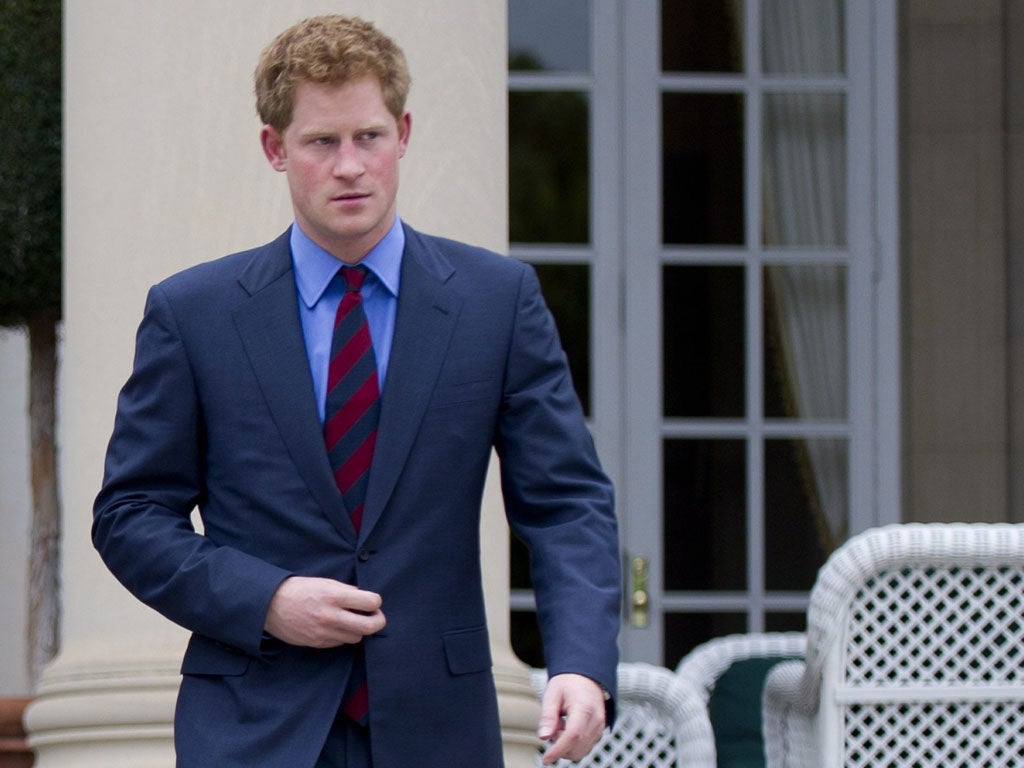How the Prince Harry affair saw red-tops deal with a new regime
Where editors would once have cried 'publish and be damned', this time they bowed to warnings

On one side ranged St James's Palace, the Press Complaints Commission and the shadow of Lord Leveson, busy drawing up recommendations on the future regulation of newspapers.
On the other lay the most talked-about pictures in the world: juicy images of the party-loving third-in-line to the throne, stark naked, promising a summer windfall guaranteed to rack up web hits and boost tabloid sales.
But where editors would once have cried "publish and be damned" and argued their case in court, on this occasion – at least initially – they reluctantly bowed to legal warnings not to publish pictures of a naked Prince Harry.
This outward display of responsibility, designed to safeguard the industry's long-term future, came at a price. The tabloids condemned a "farcical" situation which allowed web users around the world to view images which were denied to British print readers.
The issue then became less one of privacy, but of a battle between print and web. After an initial reluctance, The Sun to broke ranks last night and announced that it would be the first British newspaper to publish the photographs.
The newspaper's managing editor, David Dinsmore, explained the decision to publish the pictures was because the issue has become one of "the freedom of the Press".
"This is about the ludicrous situation where a picture can be seen by hundreds of millions of people around the world on the internet, but can't be seen in the nation's favourite paper read by 8 million people every day," he said.
A St James's Palace spokesman said: "We have made our views on Prince Harry's privacy known. Newspapers regulate themselves, so the publication of the photographs is ultimately a decision for editors to make."
Prior to The Sun's publication of the pictures of Harry, clutching his groin area during a game of "strip billiards" and bear-hugging a girl from behind during a party in his Las Vegas hotel suite, they had spread virally on social media after appearing on the US TMZ gossip website – prompting agonised debate in tabloid newsrooms.
Harbottle & Lewis, Prince Charles' lawyers, issued a note via the Press Complaints Commission, warning editors that the pictures should not be published as they were taken on "an entirely private occasion" where Harry had a "reasonable expectation of privacy".
With Lord Leveson compiling recommendations on a new system of press regulation, executives were fearful of any controversy over privacy which might nudge the judge towards proposing a statutory regime. US networks ran versions of the pictures on news bulletins and they appeared on the websites of the LA Times and Time. Until today, no British papers ran the pictures. Insiders suggested that the cautious approach, likely to play well with legislators when they consider Leveson's report, would outweigh the short-term gain from publishing pictures over which exclusivity had disappeared.
The Sun, Daily Mail and Daily Mirror are understood to have still explored a "public interest" defence which could override the UK privacy stipulations. Those newspapers were losing millions of website views, a crucial source of advertising revenue, by failing to run the pictures.
Since Harry's round-the-clock protection team had allowed him to get into a compromising situation, which could have left the Prince open to blackmail, the Mail and the Mirror asked whether the security issues raised might justify publication.
In Thursday's edition, in place of the originals, The Sun "mocked-up" the images on its front page, asking a 21-year-old undertaking work experience, Sophie Henderson, to strip and pose with picture editor Harry Miller. A caption said the pair had been "happy to strip" but the image, after initially appearing on the paper's website, was removed. Henderson tweeted: "lol 5 mins of fame #cringin". The paper said that the intern had not been placed under any pressure to strip for the camera and the picture had been published online "in error".
British newpapers, denied their picture boon, vented their anger at St James's Palace. The Mail wrote: "Farcically, British websites, newspapers and television stations were prevented from reproducing them after Prince Charles instructed lawyers to threaten legal action for infringing Harry's privacy."
The Daily Mirror remarked that censoring "won't save Harry's blushes".
"It was an extraordinary decision not to publish," said Professor Tim Luckhurst of the University of Kent's Centre for Journalism. "Newspapers want to demonstrate impeccable behaviour on privacy. But there was a powerful public interest defence. These were not paparazzi pictures… Did Harry have a legitimate expectation of privacy given that he invited these girls to his suite and allowed pictures to be taken?"
Join our commenting forum
Join thought-provoking conversations, follow other Independent readers and see their replies
Comments